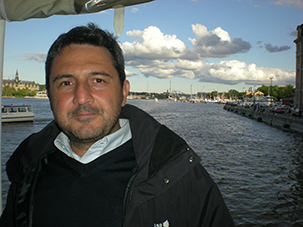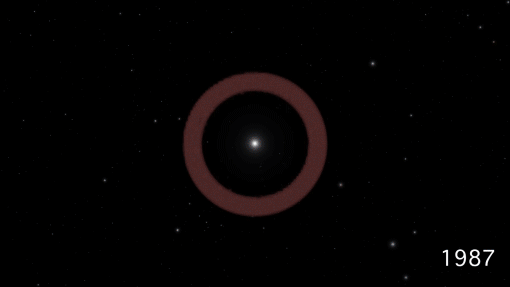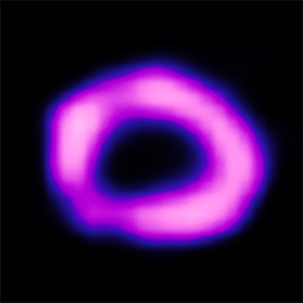Visualizing Supernova 1987A in Three Dimensions

Salvatore Orlando
Our latest press release features work by Salvatore Orlando, an astrophysicist working at the INAF-Osservatorio Astronomico di Palermo in Italy. Salvatore and his colleagues have developed the first three-dimensional model of the famous object Supernova 1987A that links the supernova to its remnant, an accomplishment that will help scientists and the public explore this important stellar object like never before. We are very pleased to share answers that Salvatore has provided to our questions about his 3D modeling.
Salvatore graduated in physics from the University of Palermo and completed his PhD at the same university. During his PhD he spent part of this time at the Dept. of Astronomy and Astrophysics at the University of Chicago. Prior to his current position, he was a research fellow for two years at the European Space Agency (ESA), Space Science Dept. (Noordwijk, The Netherlands). His main research activity has been performed in the realm of optically thin astrophysical plasmas (more specifically solar and stellar coronae, supernova remnants) and in the field of thermal and non-thermal (synchrotron) emission processes.
— Why is SN 1987A an outstanding object for astronomers to study?
The supernova occurred in a nearby galaxy, making it the nearest supernova explosion observed in hundreds of years. It therefore offers a unique opportunity to watch a supernova change into a supernova remnant. The intense radiation emitted by a supernova lasts for several months before fading away. In the meantime, the rapidly expanding (millions of miles per hour) matter from the explosion eventually crashes into surrounding gas. This collision creates a supernova remnant consisting of hot gas and high-energy particles that glow in light from radio through X-ray wavelengths for thousands of years.
— What were the goals of your study of SN 1987A?
We have three main goals: (1) to study the properties of the supernova explosion, including the structure of the stellar debris, the amount of energy produced and the amount of mass involved in the explosion; (2) to study the structure and geometry of the surrounding gas, giving insight into the final stages of the doomed progenitor star's life; and (3) to investigate the intimate link that exists between supernovas and their remnants. The other people involved in this study are Marco Miceli (University of Palermo), Fabrizio Bocchino (INAF/OAPA), and Maria Letizia Pumo (INAF/OAPA).

Supernova 1987A Visualization
— How did you address these questions?
We studied the supernova explosion's interaction with surrounding gas using X-ray data. Observations with NASA's Chandra X-ray Observatory were especially useful because they provided the sharpest X-ray images available. We compared these X-ray data with a computer model of the explosion and its aftermath, following the three-dimensional expansion of the supernova remnant. The calculation required the use of thousands of CPUs and millions of computing hours.
— What assumptions and physics were involved in your modeling?
The stellar debris ejected during the supernova explosion (the so-called ejecta) and the material surrounding the supernova (namely the nebula around SN 1987A) were treated as fluids by performing hydrodynamic modeling. The first day after the SN event was described by a complex model that takes into account all the important physical processes occurring in the immediate aftermath of the explosion, as well as the complex interaction of matter and radiation, and relativistic effects. Then the subsequent evolution was followed with a hydrodynamic model that describes the expansion of the ejecta and their interaction with the nebula. The model includes physical effects such as the cooling of plasma (that is, gas where electrons have been stripped from their atoms) due to radiation. We performed an extended exploration of the space of parameters characterizing the model by searching for the model that did the best job of reproducing the observations.
Our favored model reproduces all of the main observables of the supernova (namely how the radiation, temperature and velocity of the stellar debris vary with time) during the first 250 days after explosion. For the 30 years since the explosion our model also agrees with the observed shape of the structure seen in X-rays, as well as the amount of X-rays observed with Chandra at different wavelengths, i.e. the X-ray spectrum.
This is an amazing result because it demonstrates that the physical model reproducing the observables of the supernova can also explain what we see in the subsequent expanding remnant. In other words, we have demonstrated the consistency between the cause (the supernova explosion) and the effect (the interaction of the remnant with the surrounding medium). This provides a firm link between two research fields (supernova explosions and supernova remnant evolution), which, traditionally, are based on models that are independent from each other.

X-ray Image of Supernova 1987A
— What did you learn about the final stages of the progenitor star's life?
The model allowed us to reconstruct in detail the environment around SN 1987A before the supernova happened. In particular we were able to derive the geometry and density distribution of the gas composing the nebula and the physical characteristics of the dense equatorial ring evident in many observations taken prior to 1987. This is important because it provides useful constraints for models which try to explain how the nebula and the ring were generated in the final stages of the progenitor star evolution and, therefore, useful clues on the final stages of the progenitor star's life.
— What did you learn about the supernova explosion and about the evolution of the supernova remnant?
Thanks to the model we constrained the explosion energy of the supernova in the range 1.2-1.4 x 1051 erg and the envelope mass in the range 15-17 times the mass of the sun. These values are within the ranges expected for exploding blue supergiants and help to constrain the explosion model for SN 1987A. But, probably one of the most exciting results we found has been to identify the imprint of the supernova on the remnant X-ray emission during the first phase of evolution. In fact, we show that the X-ray spectra and the way the X-rays vary with time at early epochs (that is, less than 15 years after the explosion) reflect the structure of the outermost ejecta. Thus, by comparing the model with X-ray observations, we reconstructed the average structure of the outer ejecta. Again, this result provides some clues to models describing the supernova explosion. At later epochs, we found that the X-ray emission from the remnant reflects the density structure of the dense equatorial ring. This enabled us to ascertain that the emission revealed by X-ray observations originates from plasma components with different temperatures, allowing us to disentangle the imprint of the supernova on the remnant emission from the effects of the remnant interaction with the environment. The latter result was crucial to reconstruct the pre-supernova structure of the nebula.
— Your models extend 10 years into the future. What predictions do you make for the evolution of the SN 1987A supernova remnant?
We extended the evolution of the remnant to make predictions about the ejecta evolution and the future changes in the remnant morphology and X-ray spectrum. In this way, the model might be a useful guide for observations in the near future. In particular, the model predicts that the supernova blast is now leaving the dense ring and, in the next 4-5 years, the X-ray emission will be dominated by ejecta heated up due to them crashing into the nebula. This prediction was recently supported by new findings from the analysis of the latest Chandra observations of SN 1987A, which show that the blast wave has moved into a lower density region beyond the equatorial ring (Frank et al. 2016, ApJ 829, 40, in preprint form here). According to the model, the X-ray emission in the near future will reflect the structure of the outer ejecta and, therefore, will enable us to study in more detail the ejecta asymmetries and the distribution of metal-rich layers. This will provide important clues about the dynamics of the explosion and might even improve our knowledge about the nucleosynthesis processes occurring in the latest stage of stellar evolution and during the supernova explosion, making the remnant of SN 1987A a unique probe of core-collapse supernovas. — What does your model teach us about the detectability of the central compact objected formed in the supernova?
The existence of the yet undetected central compact object (that is, a neutron star or black hole) is one of the most debated issues about SN 1987A. Our model describes the distribution of the ejecta (shocked and unshocked) as well as the complex environment around the star, thus providing a thorough description of the local absorption in the remnant. We found that the emission of the compact object cannot be revealed yet due to a heavy local absorption that is a factor of 20 higher than the interstellar absorption toward the Large Magellanic Cloud. The model predicts that in the next 10 years the local absorption may be reduced by a factor of two, but this is probably not enough to make the compact object detectable. We also constrained the thermal emission from the central source finding a good agreement with standard theories of neutron star cooling. In other words, the compact object might very well be there, but we can't see it because there is too much material surrounding it right now and perhaps for a long time to come.
Category:
- Log in to post comments

Comments
marcusbaytbm
Fri, 2017-03-24 11:40
Permalink
Great article
I see the white dwarf doesn't seem to be in danger of being totally dragged into the black hole—or being torn apart from a distance.